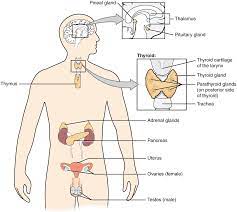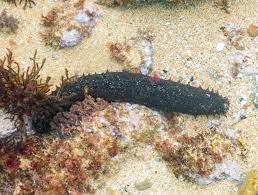Ancient Critters Made Human Hormone System What It Is Today
I bet you weren’t expecting to read about sea cucumbers when clicking on a hormone blog, did you? Surprise! That is what this article is all about...sort of. We’ll be exploring the ancient origins of our endocrine system and its evolutionary history, which just so happens to be traced back to sea cucumbers. Neat, huh? Let’s begin on our journey through time…
Proteins Essential for Reproduction, Metabolism, and Immunity Traced Back to Sea Cucumbers
We love to study evolution and understand how we got to where we are today in terms of our genetics, our technology, our cultural history, etc. Scientists from the Marine Science and Technology College in China decided to pursue a study investigating the evolutionary history of our endocrine (hormone)  system.
system.
They found that a critical set of proteins that aid in hormone regulation and are necessary for many essential functions in humans and other vertebrates have origins that can be traced back to more primitive creatures: sea cucumbers. Who would have thought?
The group of proteins that they focused on is part of a system called the kisspeptin system. The kisspeptin system controls hormones released by the human body's three main endocrine glands: the hypothalamus, the pituitary gland, and the sex organs of both men (testicles) and women (ovaries). These three endocrine glands regulate significant processes, including reproduction, the immune system, metabolism, and more. Let’s delve into these organs a bit further…
The Basics of the Endocrine System
The endocrine, or hormone system, is a collection of glands or organs that produce hormones. Besides the three previously mentioned, other glands are involved, including the thyroid gland and adrenal glands. The word endocrine is derived from the Greek words “endo,” which means “within,”  and “crinis” which means to secrete. A gland selectively uptakes materials from the blood, processes them, and secretes a finished biochemical product (hormone, protein, enzyme) for use in other body areas. Our endocrine system is so important because it acts on almost every organ and cell in our bodies.
and “crinis” which means to secrete. A gland selectively uptakes materials from the blood, processes them, and secretes a finished biochemical product (hormone, protein, enzyme) for use in other body areas. Our endocrine system is so important because it acts on almost every organ and cell in our bodies.
Each type of hormone, such as growth hormone or estrogen, circulates through the bloodstream to targeted organs and tissues. Once the hormone reaches its destination, it will begin a chain reaction within the cell, such as the production of sperm or the breakdown of fat for energy use. Hormones are what keep our bodies running efficiently or running at all.
Hypothalamus: The hypothalamus is a small section in the brain's center with the central role of keeping the body and/or endocrine system in homeostasis (or balance) as much as possible. Quite the job!
The hypothalamus is the connector between the endocrine system and the nervous system. Because of this connection, it plays a part in body temperature, appetite/hunger, emotions, sleep, blood pressure, the balance of bodily fluids, etc.
As different parts of the body send signals to the brain, they tell the hypothalamus about any unbalanced factors that need to be fixed. For example, if the internal temperature is too high, the hypothalamus tells the body to start sweating.
Pituitary Gland: The pituitary gland sits underneath the brain, at the base of the skull in a bony hollow, connected to the hypothalamus, and is considered the “master gland.” Even though it is the “master gland,” which regulates several vital functions and controls the activity of other glands, it is only the size of a pea. The anterior portion is connected to the brain by blood vessels, and the posterior portion is actually a part of the brain and secretes hormones directly into the bloodstream.
Most of the time, the hypothalamus acts on the pituitary gland first and stimulates it to release the hormones that the body needs, but not with every hormone.
The pituitary gland secretes a variety of hormones, including prolactin (which induces milk production in the breasts), growth hormone (which regulates growth, metabolism, and body composition), luteinizing hormone (LH), and follicle-stimulating hormone (FSH – for sex hormone production and other activities in the sex organs) and thyroid-stimulating hormone (stimulates the thyroid gland to secrete thyroid hormones).
Sex Organs – The sex organs comprise the testicles in men and the ovaries in women. They both can secrete their hormones, such as testosterone and estrogen. The secretion of these hormones stimulates processes such as puberty, egg maturation, and sperm production.
Evolutionary Origins of Kisspeptin Proteins
Now that you know more about the endocrine system and the central trio composing the kisspeptin system (hypothalamus, pituitary gland, and sex organs), we can delve into their evolutionary origins.
Lead author, Tianming Wang, stated, “The origins of these proteins have previously been traced to straightforward creatures with spinal cords, but it hadn’t been traced back any further. This raises an important question: does the kisspeptin system have an ancient evolutionary origin, or did it first emerge in animals with spinal cords?”
Wang and his team wanted to answer this question. To do so, they looked for kisspeptin system genes in the sea cucumber. Sea cucumbers are straightforward creatures that have no spinal cord. The scientists could identify equivalents of the kisspeptin genes in the squishy little creatures.
Next on the scientist’s agenda was administering kisspeptin-like cucumber proteins into mammal cells to see what would happen. This caused the mammal cells to secrete calcium, similar to how human versions of the protein would behave.
These sea cucumber proteins were able to interact with receptors in human cells as well. This finding suggests that not much has changed in these proteins over years of evolution.
The scientist’s final phase of experiments consisted of activating or blocking the signaling system in sea cucumbers. By blocking these proteins from being produced, it became clear that they are critical for such vital functions as reproduction and metabolism in sea cucumbers.
Endocrine System Predates Evolution of Spinal Cord
The senior author of the study, Naiming Zhou, says that their experiments suggest that the kisspeptin system actually predates the evolution of the spinal cord in animals and would also be present in other animals that are closely related to the sea cucumber.
Zhou states, “Our findings indicate the existence of a kisspeptin signaling system in a very simple organism lacking a spinal cord. They provide new evidence to support the ancient evolutionary origin of the physiological functions in vertebrates controlled by the kisspeptin system.”
There you have it, folks. Our hormones and endocrine system can be traced back to primitive sea creatures. Fascinating, indeed. Continue to follow our blog for more exciting and up-to-date hormone news!
Reference
- What Is Adrenal Fatigue [Last Updated On: August 20th, 2024] [Originally Added On: October 23rd, 2020]
- Understanding Thyroid Function And Diagnosing Thyroid Issues [Last Updated On: August 21st, 2024] [Originally Added On: October 24th, 2020]
- Twelve Steps To Enhance And Preserve Your Memory [Last Updated On: January 28th, 2025] [Originally Added On: October 25th, 2020]
- The Psychological And Physiological Effects Of Serotonin [Last Updated On: January 28th, 2025] [Originally Added On: October 26th, 2020]
- The Facts About Psoriasis: Symptoms And Causes [Last Updated On: January 27th, 2025] [Originally Added On: October 27th, 2020]
- The Facts About Acromegaly [Last Updated On: August 24th, 2024] [Originally Added On: October 28th, 2020]
- The Effects Of Hgh Deficiency Upon One Of A Pair Of Twins [Last Updated On: January 27th, 2025] [Originally Added On: October 29th, 2020]
- Resveratrol Anti-aging Supplementation For Longevity [Last Updated On: August 19th, 2024] [Originally Added On: October 30th, 2020]
- Sermorelin Acetate Injections With Ghrp-6 [Last Updated On: February 18th, 2025] [Originally Added On: October 31st, 2020]
- Melatonin The Sleep Hormone How It Impacts Your Health [Last Updated On: August 26th, 2024] [Originally Added On: November 1st, 2020]
- Mark Cuban To Fund Study On Healing Power Of Hgh [Last Updated On: August 27th, 2024] [Originally Added On: November 2nd, 2020]
- Mark Cuban Advocates For Hgh As A Rehab And Recovery Tool [Last Updated On: January 26th, 2025] [Originally Added On: November 3rd, 2020]
- Leptin Hormone Guide: The Effects Of The Satiety Hormone [Last Updated On: January 26th, 2025] [Originally Added On: November 4th, 2020]
- Human Growth Hormone Deficiency Impact On Sleeping Habits [Last Updated On: January 25th, 2025] [Originally Added On: November 5th, 2020]
- Human Growth Hormone And Liver Regeneration [Last Updated On: January 25th, 2025] [Originally Added On: November 6th, 2020]
- Hgh Treatment For Fatty Liver Disease On The Horizon [Last Updated On: February 17th, 2025] [Originally Added On: November 7th, 2020]
- Your Current HGH Level [Last Updated On: June 27th, 2024] [Originally Added On: November 8th, 2020]
- Ghrelin The Hunger Hormone [Last Updated On: January 24th, 2025] [Originally Added On: November 9th, 2020]
- Enclomiphene Citrate Andropause Treatment Up For Fda Approval [Last Updated On: January 24th, 2025] [Originally Added On: November 10th, 2020]
- Dopamine Pleasure Hormone And So Much More [Last Updated On: July 27th, 2024] [Originally Added On: November 11th, 2020]
- Diabetes Cure On The Horizon [Last Updated On: January 23rd, 2025] [Originally Added On: November 12th, 2020]
- Boost Metabolism To Lose Weight And Maintain Weight Loss [Last Updated On: January 23rd, 2025] [Originally Added On: November 13th, 2020]
- Andropause A Mid-life Hormone Crisis [Last Updated On: February 18th, 2025] [Originally Added On: November 14th, 2020]
- SOGROYA INJECTIONS FOR HUMAN GROWTH HORMONE DEFICIENCY [Last Updated On: February 19th, 2025] [Originally Added On: March 24th, 2021]
- How Do High and Low Estrogen Impact Male Health and Wellness? [Last Updated On: February 9th, 2025] [Originally Added On: April 2nd, 2021]
- The Effects Of Hormone Imbalance On Belly Fat [Last Updated On: February 18th, 2025] [Originally Added On: May 8th, 2021]
- Could Sunlight Help Remove Rogue Hormones from the Water Supply? [Last Updated On: February 20th, 2025] [Originally Added On: May 29th, 2021]
- Weekly HGH Therapy Just as Effective as Daily Injections [Last Updated On: July 5th, 2024] [Originally Added On: June 18th, 2021]
- DHEA and Testosterone: A winning team! [Last Updated On: February 14th, 2025] [Originally Added On: January 19th, 2022]
- Animal Research Discovers Link Between Exercise, HGH, and Cognitive Ability [Last Updated On: February 14th, 2025] [Originally Added On: May 20th, 2022]
- Weekly Hormone Treatments for Adult HGH Deficiency with Sogroya [Last Updated On: February 18th, 2025] [Originally Added On: June 14th, 2022]
- How Substance Abuse Can Affect Your Hormone Levels [Last Updated On: March 16th, 2025] [Originally Added On: August 4th, 2022]
- A Holistic Approach to Health and Water Safety [Last Updated On: February 7th, 2025] [Originally Added On: February 7th, 2025]
- Understanding the Role of Sogroya in Adult Human Growth Hormone (HGH) Deficiency Treatment [Last Updated On: February 12th, 2025] [Originally Added On: February 11th, 2025]
- Andropause: An Examination of Mid-life Hormonal Shifts in Males [Last Updated On: February 16th, 2025] [Originally Added On: February 13th, 2025]
- Sermorelin Acetate Therapy: A Comprehensive Insight into its Benefits with GHRP-6 [Last Updated On: February 17th, 2025] [Originally Added On: February 14th, 2025]
- The Dynamic Duo of Male Vitality: Testosterone and DHEA [Last Updated On: February 14th, 2025] [Originally Added On: February 14th, 2025]
Word Count: 1102







